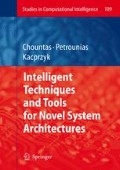Summary
In the first part of the chapter we show the three most important axiomatizations of the concept of subsethood measure. Then we present the reasons why we focus on the definition given by V. Young. Next we study a method for constructing said measures and we analyze the conditions in which they satisfy the axioms of Sinha and Dougherty. Afterwards we study the way of obtaining fuzzy entropies that fulfill the valuation property from said subsethood measures.
Access this chapter
Tax calculation will be finalised at checkout
Purchases are for personal use only
Preview
Unable to display preview. Download preview PDF.
References
L.A. Zadeh, Fuzzy sets, Information Control, 8: 338–353, 1965.
W. Bandler and L. Kohout, Fuzzy power sets and fuzzy implication operators, Fuzzy Sets and Systems, 4: 13–30, 1980.
L. Kitainik, Fuzzy inclusions and fuzzy dichotomous decision procedures, in J. Kacprzyk, S. Orlovski (Eds.), Optimization Models Using Fuzzy Sets and Possibility Theory, Reidel, Dordrecht pp. 154–170, 1987.
D. Sinha and E.R. Dougherty, Fuzzification of set inclusion: Theory and applications, Fuzzy Sets and Systems 55: 15–42, 1993.
V.R. Young, Fuzzy subsethood, Fuzzy Sets and Systems 77: 371–384, 1996.
J. Fan, X. Xie and J. Pei, Subsethood measures: new definitions, Fuzzy Sets and Systems, 106: 201–209, 1999.
D. Dubois and H. Prade, Fuzzy Sets and Systems: Theory and Applications, New York: Academic, 1980.
J. Fodor and R. Yager, Fuzzy sets theoretic operators, in D. Dubois, H. Prade (Eds.), Fundamentals of Fuzzy Sets, Kluwer, Boston, MA, pp. 125–193, 2000.
C. Cornelis, C. Van der Donk and E. Kerre, Sinha-Dougherty approach to the fuzzification of set inclusion revisited, Fuzzy Sets and Systems, 134: 283–295, 2003.
A. Kehagias and M. Konstantinidou, L-Fuzzy Valued Inclusion Measure, L-Fuzzy Similarity and L-Fuzzy Distance, Fuzzy Sets ans Systems, 136: 313–332, 2003.
R. Willmott, On the transitivity of containment and equivalence in fuzzy power set theory, Internatinal Journal of Mathematical Analysis and Application, 120: 384–396, 1986.
S. Kundu, A representation theorem for min-transitive fuzzy relations, Fuzzy Sets and Systems, 109: 453–457, 2000.
N. Frago, Morfologia matematica borrosa basada on operadores generalizados de Lukasiwicz: procedimiento de imagenes, Ph.D. dissertation (in Spanish), Universidad publica de Navarra, 1996.
B. Kosko, L-fuzzy sets, Journal of Mathematical Analysis and Application, 18: 145–174, 1967.
B. Kosko, The logic of inexact concepts, Synthese, 19: 325–373, 1969.
B. Kosko, Fuzziness vs. probability, Internationl Journal of General Systerm, 17: 211–240, 1990.
B. Kosko, Fuzzy entropy and conditioning, Information Science, 40: 165–174, 1986.
H. Bustince, J. Montero, E. Barrenechea and M. Pagola, Semiautoduality in a restricted family of aggregation operators, Fuzzy Sets and Systems, 158(12): 1360–1377, 2007.
H. Bustince, V. Mohedano, E. Barrenechea and M. Pagola, Definition and Construction of Fuzzy DI-subsethood Measures, Information Sciences, 176(21): 3190–3231, 2006.
D. Dubois and H. Prade, Criteria aggregation and ranking of alternatives in the framework of fuzzy theory, in: H.J. Zimmermann, L.A. Zadeh, B. Gaines (Eds.), Fuzzy Sets and Decision Analysis, TIMS Studies in Management Science, vol. 20, pp. 209–240, 1984.
G. J. Klir and T. A. Forlger, Fuzzy Sets uncertainty and information, Prentice-Hall International, 1988.
E. Trillas, Sobre funciones de negación en la teoría de conjuntos difusos, Stochastica, III-1: 47–59, (in Spanish), 1979 Reprinted (English version) (1998) in: Advances of Fuzzy Logic, Eds. S. Barro et altri-Universidad de Santiago de Compostela, pp. 31–43.
A. Deluca and S. Termini, A definition of a nonprobabilistic entropy in the setting of fuzzy set theory, Inform and Control, 20: 301–312, 1972.
B. Ebanks, On measures of fuzziness and their representations, Journal of Mathematical Analysis and Application, 94: 24–37, 1983.
Author information
Authors and Affiliations
Editor information
Editors and Affiliations
Rights and permissions
Copyright information
© 2008 Springer-Verlag Berlin Heidelberg
About this chapter
Cite this chapter
Bustince, H., Barrenechea, E., Pagola, M. (2008). A Method for Constructing V. Young’s Fuzzy Subsethood Measures and Fuzzy Entropies. In: Chountas, P., Petrounias, I., Kacprzyk, J. (eds) Intelligent Techniques and Tools for Novel System Architectures. Studies in Computational Intelligence, vol 109. Springer, Berlin, Heidelberg. https://doi.org/10.1007/978-3-540-77623-9_7
Download citation
DOI: https://doi.org/10.1007/978-3-540-77623-9_7
Publisher Name: Springer, Berlin, Heidelberg
Print ISBN: 978-3-540-77621-5
Online ISBN: 978-3-540-77623-9
eBook Packages: EngineeringEngineering (R0)

